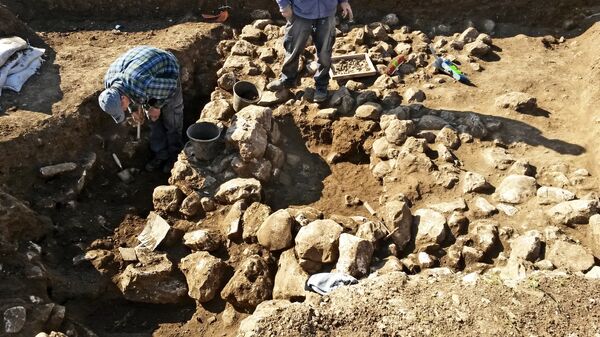The site was discovered in the vicinity of Route 6, one of the country's busiest roads which is also known as the Trans-Israel Highway. The area was once occupied by Homo erectus, according to the Israel Antiquities Authority.
READ MORE: Mysterious Stone Age Rocks, Cryptic Carvings Dazzle Danish Researchers
Ran Barkai, head of Tel Aviv University's archaeology department, who took part in the dig, said that the site is “amazingly preserved” given that it was discovered just five meters below the surface in the heavily populated area.
אתר פרהיסטורי בן כחצי מליון שנה נחשף ליד ג'לג'וליה. במקום נמצאו מאות אבני צור שיוצרו בידי האדם הקדמון, ה"הוֹמוֹ־אֵרֶקְטוּס", ושימשו אותו לחיתוך מזון ולציד. להערכת ארכיאולוגים האתר עשיר בממצאים מכיוון שהאזור סיפק את כל צרכיו הבסיסיים של האדם הקדמון @GilLitman (צילום: רשות העתיקות) pic.twitter.com/fOcejwB42c
— כאן חדשות (@kann_news) 7 января 2018 г.
TWEET: A prehistoric site dating back half a million years ago was discovered near Jaljuliya. Hundreds of flint tools produced by ancient humans, the Homo-erectus, were found at the site
“It was a perfect spot for humans,” Barkai commented to Haaretz about the site. “The water brought flint nodules from the hills, which were used to make tools on the spot, and it attracted animals, which were hunted and butchered here. They had everything that prehistoric people needed.”
The archaeologist suggested people could have visited the place as part of the seasonal cycle, describing it as “a paradise” for them.
READ MORE: New Tests Shed Light on Bones Found at Centuries-Old Mystery Site in Scotland
The discovery may also shed a light on how the humanity evolved, according to scientists. The flint tools that were uncovered at the site were made using the so-called Levallois technique, which is often attributed to Homo sapiens rather than Homo erectus.

